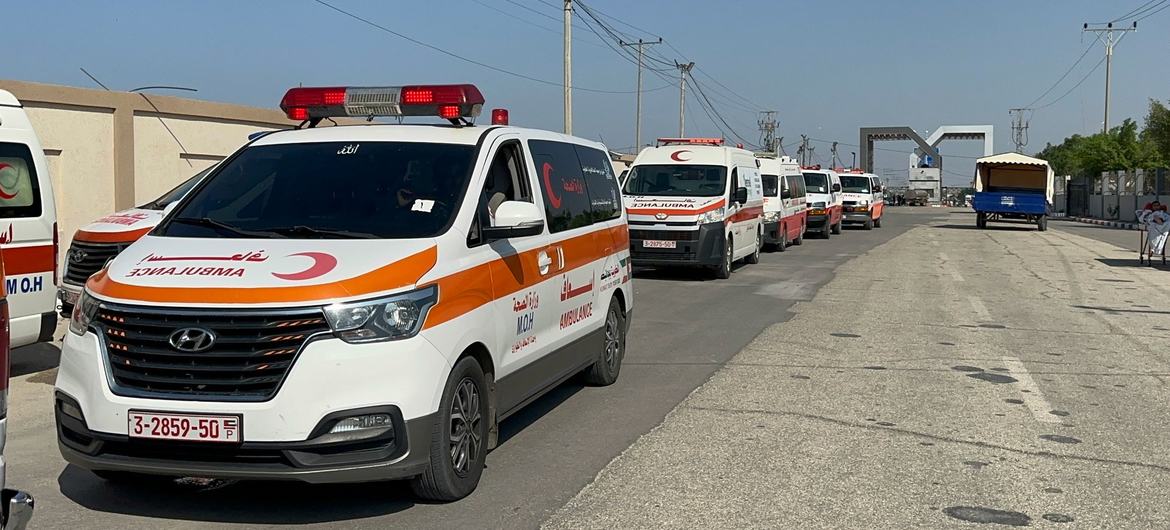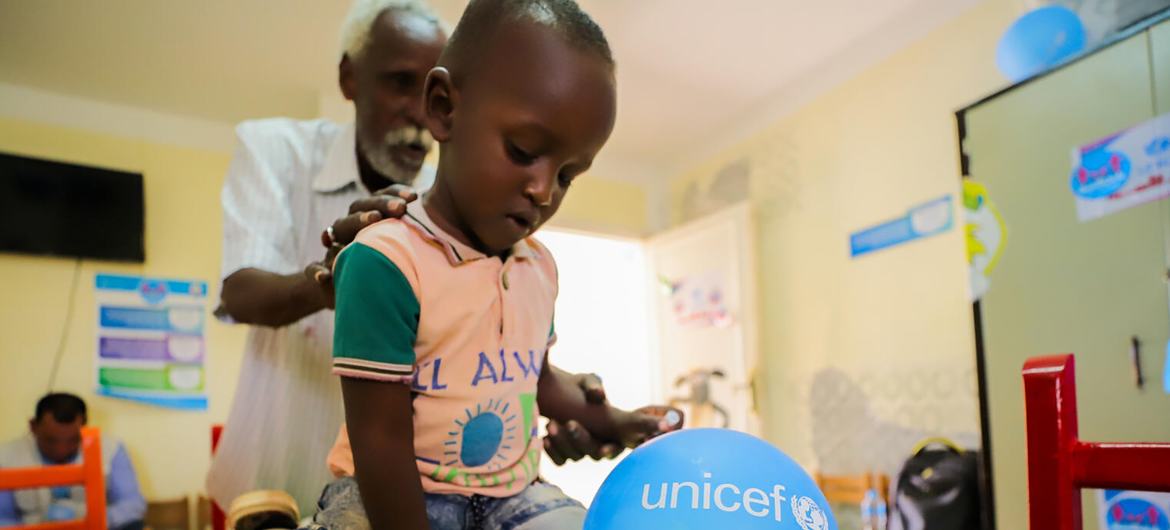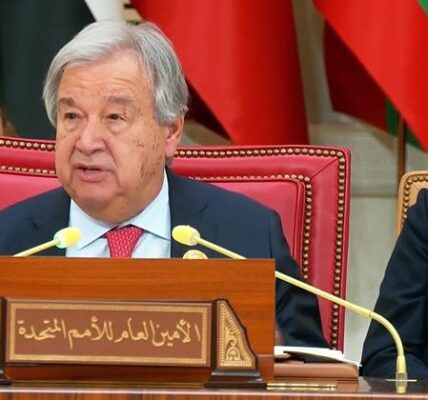An interview discussing Egypt’s significant role in providing aid to Gaza and Sudan.
UN News interviewed Elena Panova, UN Resident Coordinator in Egypt, and Neveen Alqabbaj, Vice-President of the Egyptian Red Crescent Society and Egypt’s Minister of Social Solidarity, to discuss the delivery of thousands of tonnes of aid and lifesaving services during times of crisis.
Neveen Alqabbaj: The Egyptian Red Crescent Society has been actively involved in responding to the situation in Gaza from the beginning. We have a total of 31 emergency centers, 10 warehouses, 175 rescue teams, and 36,000 emergency volunteers and trucks. Our operations rooms are well-equipped to monitor and coordinate with the Palestinian Red Crescent, allowing for real-time exchange of data between the two organizations.
We prepared ourselves in El Arish, a location approximately 50 km from the Rafah border into Gaza where numerous international aid shipments are delivered by air. We work with both local and international non-governmental organizations (NGOs) to guarantee that we have the necessary supplies.
Elena Panova: Due to the unfolding crises in Gaza and Sudan, the 27 UN agencies in Egypt have had to shift their focus to increasing our efforts. These emergencies have prompted us to reassess our methods of operation as we are now in a state of urgency.
The United Nations in Egypt is collaborating closely with the Egyptian Red Crescent Society and has sent a small team of humanitarian experts to El Arish. This team includes logisticians and individuals who specialize in aid coordination and information management.
The group assists the Red Crescent Society in managing their storage facilities in El Arish. The WFP has supplied additional mobile warehouses, while UN agencies have contributed trucks, forklifts, generators, and pallets. Of the 4,008 trucks that have arrived in Gaza, approximately 35% contain aid provided by the UN, made possible by generous donors.

Ambulances transport injured Palestinians from Gaza to Egypt via the Rafah crossing.
Can you explain the steps involved in controlling and allowing access through the Rafah crossing, as well as any challenges you encounter? How does the UN in Egypt support the delivery of aid?
I am making sure that all items are going through the gates at the Rafah border. We have a complete plan in place and are working quickly to respond. The Rafah crossing was the only way to bring significant assistance into Gaza.
In the beginning, there were only 20 trucks per day. Over time, this number has gradually increased to 200 trucks per day. However, the Palestinian people require around 500 to 600 trucks per day. This means that we are only meeting 30% of their actual needs.
We are facing difficulties due to the numerous requests made by the Israeli authorities. Each truck is required to travel approximately 50 kilometers from El Arish to be inspected at the Nitzana border crossing before returning to Rafah. We have become familiar with the necessary requirements over time. Additionally, we are streamlining the process by automating the information and data provided at Rafah.

During a temporary ceasefire in November, the World Food Programme (WFP) collected essential supplies at the Rafah crossing and distributed them to inaccessible locations in Gaza City as part of a joint operation with other agencies.
Elena Panova: This is a highly intricate procedure and its intricacy should not be underestimated. Our efforts at the UN are aimed at improving efficiency and predictability.
Our goal is to ensure that the contents of these trucks are essential for Gaza. We assist the Egyptian Red Crescent in prioritizing based on information provided by our colleagues on the other side of the border, particularly the UN agency for Palestine refugees (UNRWA) and the Palestinian Red Crescent Society.
An instance of improving effectiveness is implementing a QR code system for aid trucks. Individuals with a mobile device can scan the code to view the donor, recipient, and type of aid being delivered. This is crucial for efficiently managing transportation and ensuring transparency in aid distribution to Gaza.

In November, a second mission to Al-Shifa Hospital in Gaza was led by the World Health Organization (WHO) in collaboration with the UN and the Palestine Red Crescent Society. (file)
Can you provide an explanation for the recent medical evacuations, which included premature babies, that took place through the Rafah crossing? What type of assistance do the Egyptian authorities offer to the patients and injured individuals on their side?
Neveen Alqabbaj stated that, in accordance with the President’s directives, the Egyptian government is accepting individuals who require medical assistance or have severe injuries. There are approximately 10,000 injured individuals in need of medical aid, including 4,000 children. To address this, 38 hospitals have been prepared in El Arish, Cairo, and nearby regions. Additionally, transportation has been arranged by the Egyptian authorities and NGOs to transport necessary equipment such as incubators, inhalers, and anesthesia devices.
The newborn infants admitted to El Arish Hospital have not yet been given names or birth certificates. Our team is providing individual case management for each child. In Palestine, there are approximately 52,000 expectant mothers and we facilitate an average of 183 deliveries each day. Additionally, we treat patients who have undergone amputations and those who will be quadriplegic.
Amidst the crisis, nearly all hospitals in Gaza have become inoperable, with approximately 250 medical personnel losing their lives. There is a shortage of equipment and essential supplies, resulting in a dire need for prompt evacuation of critically injured individuals.
Elena Panova: The World Health Organization (WHO) and the UN Children’s Fund (UNICEF) work closely with the Ministry of Health and Population to lead medical evacuations. All teams are assisting in improving the capabilities of hospitals in Egypt that are treating injured individuals from Gaza.
The United Nations in Egypt plays a crucial role in the rotation of necessary humanitarian personnel. We are aiding in the entry of individuals into Gaza, including our UN colleagues, admirable heroes, and courageous NGO staff who are there to support the teams. To date, over 100 vital humanitarian workers have entered Gaza.

The government in Aswan, Egypt, along with UNICEF, established a safe and welcoming area for children and their families who have escaped from Sudan.
Could you provide an update on the current number of Sudanese refugees in Egypt and the types of assistance they are receiving?
Neveen Alqabbaj: Overall, 45% of the nine million refugees in Egypt are from Sudan. During the recent crisis in Sudan, more than 300,000 families sought refuge in Egypt. The Egyptian Red Crescent was quick to respond, assisting people in safely crossing the border and relocating them to various locations within Egypt. Unlike other refugee populations, Sudanese refugees in Egypt do not reside in camps but are dispersed throughout the country.
At the entry points, we have set up service centers. Our services include humanitarian aid, hygiene kits, food and essential supplies, issuance of identification documents, and psychosocial support for children and women.
Elena Panova: Following the initial arrival of refugees in Egypt, Martin Griffiths, the UN Emergency Relief Coordinator, granted our team special funds from the Central Emergency Relief Fund (CERF) to expedite our response. Along the migration route, we implemented basic water and sanitation facilities, primarily through the efforts of UNICEF. The World Food Programme (WFP) supplied food and cash aid to 270,000 of the newly arrived individuals. In collaboration with Egyptian partners, the UN agency for reproductive health and rights, UNFPA, established safe havens for women, many of whom were escaping sexual violence during the conflict.
In the future, we will receive approximately 300 new individuals daily. We are currently addressing their urgent needs and collaborating with the Government to determine how to provide long-term support, particularly in the areas of education and health services. It is crucial that we not only assist the host communities, but also aid the Government of Egypt in developing its response to cope with these increasing challenges.
Listen to the full interview here.

Youthful Egyptian volunteers assist stranded Sudanese individuals.
Source: news.un.org



